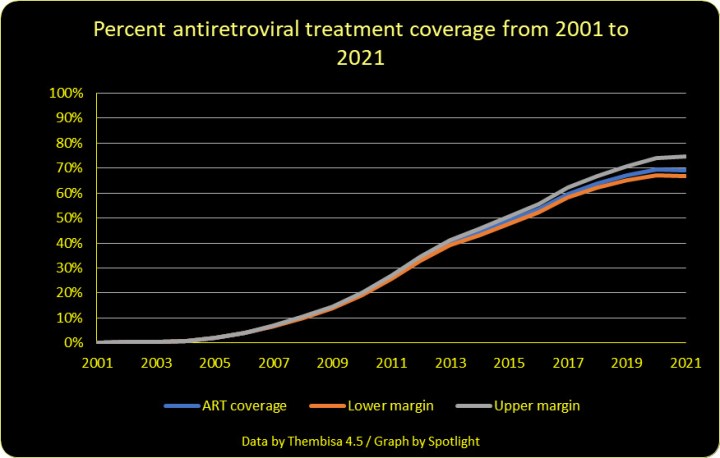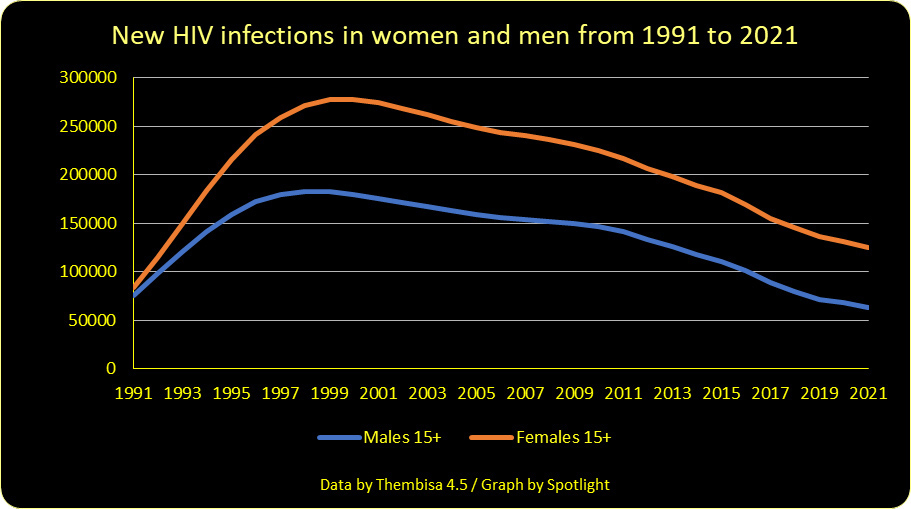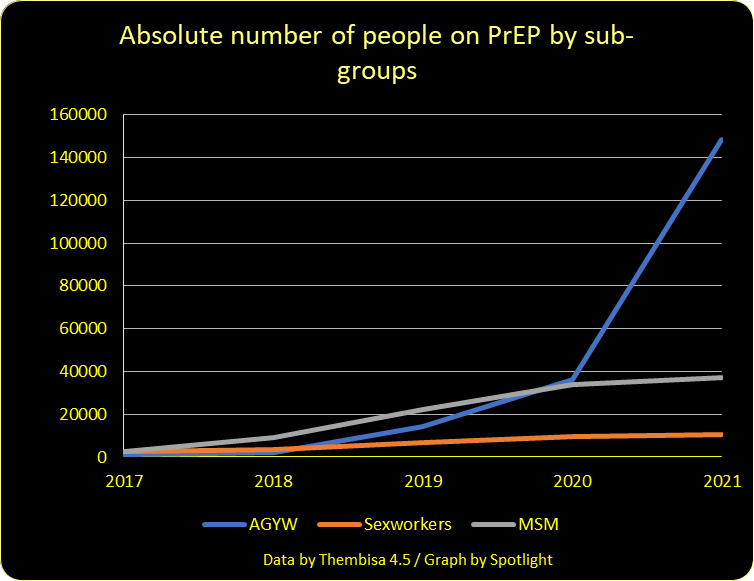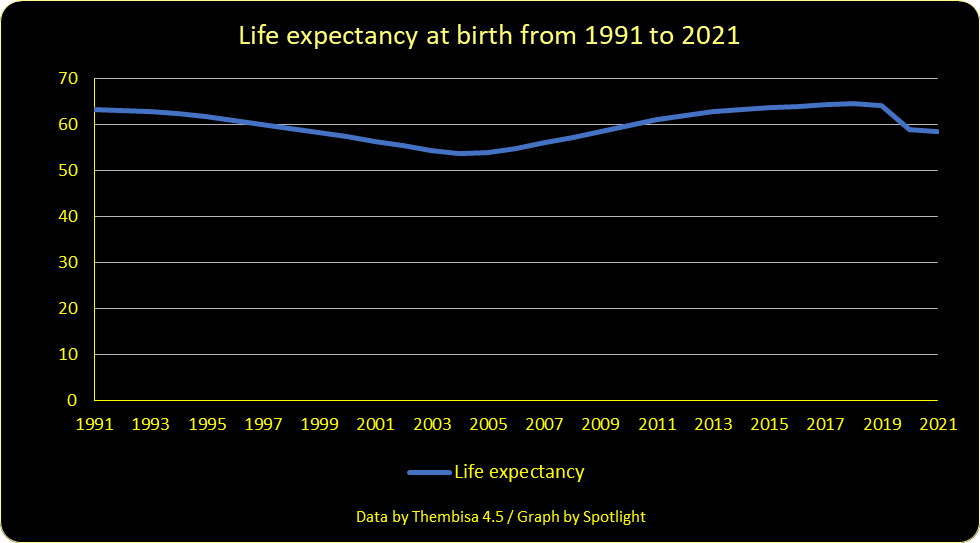SPOTLIGHT
Six graphs that tell the HIV story in South Africa

In 2021, HIV was successfully suppressed in the bodies of about 63% of the almost eight million people living with the virus in South Africa. This is according to recent outputs from Thembisa, the leading mathematical model of HIV in the country. With the help of graphs, Spotlight editor Marcus Low unpacks this and other key model outputs.
Using data from Thembisa, the following graphs provide a breakdown of HIV suppression in 2021, as well as other outputs from the mathematical model.
Big-picture numbers
The model estimates that there were about 7.9 million people living with HIV in South Africa in 2021, or 13.5% of the population. This number is anticipated to keep rising in the coming years since the rate of new HIV infections remains significantly higher than the rate of HIV-related deaths. There were an estimated 198,000 new HIV infections in 2021 and about 52,000 HIV-related deaths.

This graph shows how new HIV infections have over time remained significantly higher than HIV-related deaths. As a result of this, the absolute number of people living with HIV will keep rising for the foreseeable future.
Of the 7.9 million people living with HIV in the country in 2021, it is estimated that 93.7% have been diagnosed. This suggests that South Africa’s massive HIV testing efforts over the past decade have largely been a success.
But, while our HIV testing numbers are impressive, the picture is less rosy when it comes to helping people living with HIV to start and stay on antiretroviral treatment. Of the 7.9 million living with the virus, about 5.5 million (69%) were taking antiretrovirals in 2021. Antiretroviral treatment is recommended for all people living with HIV and this percentage should ideally be closer to 100.

This graph shows the percentage of people living with HIV in South Africa over time who are on treatment.
One alarming detail is that of the estimated 266,000 people who started antiretroviral treatment in 2021, 57,000, roughly one in five had CD4 counts below 200 cells/mm3, which indicates a significantly compromised immune system. This means a significant number of people only start treatment once they are very sick.
When people are stable on antiretroviral treatment, the virus is typically suppressed to very low levels in their bodies – so much so that they become non-infectious. Among the 5.5 million people on antiretroviral treatment, about 91% were estimated to be virally suppressed in 2021. Of the entire 7.9 million living with HIV, however, only about 63% are virally suppressed.
Women and men
The Thembisa model outputs show very clearly how the HIV epidemic is playing out differently in women and men. Broadly speaking, many more women are living with HIV than men, but men who are living with HIV are less likely to be on treatment and more likely to die of HIV-related causes.
In 2021, an estimated five million women (15 and older) and 2.7 million men were living with HIV. New HIV infections in women were close to double that in men – 124,400 in women compared with 63,500 in men.

This graph shows the dramatic difference in new HIV infections in women and men over time.
Given that many more women than men are living with HIV, it is not surprising that more women are on treatment than men, but the extent of the difference is eye-opening. In 2021, an estimated 3.7 million women were on treatment, more than double the 1.6 million men. The difference in people newly started on treatment in 2021 is a little less stark – 159,000 women compared with 99,000 men.
While many more women are living with HIV than men, more men are dying from HIV-related causes. In 2021, about 27,500 men died from HIV-related causes compared with 22,200 women.

This graph compares HIV-related deaths in women and men over time. Read together with the previous graph, it illustrates how differently the HIV epidemic has played out in women and men.
One HIV prevention intervention squarely focused on men and boys, voluntary medical male circumcision, took a significant knock in 2020 as the Covid-19 pandemic resulted in the temporary shutting down or downscaling of circumcision programmes. In each of 2017, 2018 and 2019, more than 200,000 boys aged 10 to 14 were medically circumcised. This dropped to below 70,000 in 2020 but bounced back to more than 200,000 in 2021. Older age groups saw similar drops in 2020 followed by solid recoveries in 2021.
HIV still a problem for infants and children
In 2021, it is estimated there were just more than 8,300 cases of mother-to-child transmission of HIV. On the one hand, this is a dramatic improvement on the early 2000s when the number hovered around 74,000. On the other hand, it seems remarkable that in 2022 something as preventable as mother-to-child transmission of HIV is still a substantial problem.
The details are interesting.
Of the more than 8,300 cases of mother-to-child transmission in 2021, about 2,800 occurred at or before birth – the majority (5,600) occurred during breastfeeding. One likely explanation is that some women are contracting HIV in the months after having given birth and then transmission to their babies takes place before they are diagnosed and their HIV viral load can be brought under control using antiretroviral therapy.
Either way, HIV in children remains far from over. About 238,000 children (under the age of 15) were living with HIV in 2021.
Signs of PrEP scale-up
One of the most encouraging things in the new Thembisa outputs is the uptick it shows in PrEP use in 2021 – albeit from a very low base. PrEP (pre-exposure prophylaxis) refers to HIV-negative people taking antiretroviral drugs to prevent HIV infection. For now, PrEP is only available as a pill in the public sector, but a vaginal ring and an injection administered every two months should also become available in the coming year or two.
PrEP coverage in sexually active individuals is estimated to have increased from 0.1% in 2019 to 0.3% in 2020, and to 1% in 2021. Coverage in sexually active women (1.3%) in 2021 was better than that in sexually active men (0.7%). Coverage was estimated to be much higher for groups that have been targeted for PrEP for a few years now, such as female sex workers (21.7%) and men who have sex with men (14%). Coverage in sexually active adolescent girls and young women was estimated to be 5.1% – a promising sign given the persistently high number of new infections in this group.

This graph shows PrEP uptake in terms of absolute numbers (rather than percentages) in sex workers, men who have sex with men, and adolescent girls and young women.
Covid-19 sets back life expectancy
For most of the past two or so decades, HIV has been a key driver of life expectancy in South Africa. Life expectancy dropped precipitously from the mid-Nineties to 2004 because of HIV-related deaths and then recovered due to the roll-out of antiretroviral treatment which prevented people living with HIV from dying. Outputs from the Thembisa model have always shown this dynamic very clearly.

This graph shows how life expectancy at birth in South Africa has changed over the past three decades.
The latest Thembisa outputs, however, also show how Covid-19 has temporarily derailed the upward trend in life expectancy. Having recovered from about 54 years in 2004 to 64 in 2019, the pandemic knocked life expectancy back to between 58 and 59 in 2020 and 2021. DM/MC
Note: In this article, we quote outputs from Thembisa version 4.5 only up to 2021. There are also Thembisa outputs for 2022 and future years, although these are much more uncertain. We have rounded some of the numbers for easier reading. Low takes sole responsibility for any and all errors.
Technical note: In Thembisa outputs stock variables (e.g. total HIV infections, population size) refer to the middle of the year in question and flow variables (e.g. new HIV infections, Aids deaths and total births) cover the period from the middle of the stated year to the middle of the next year.
This article was published by Spotlight – health journalism in the public interest.





















 Become an Insider
Become an Insider
The fact that there is treatment is wonderful, but clearly all attempts to prevent HIV infection have failed miserably. The different figures for men and women reveal how men infect multiple women and girls: is this a success story after more than 25 years of education and free condoms? I think not.